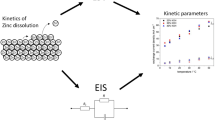Abstract
An attractive way of determining the electrode kinetics of very fast dissolution reactions is that of measuring the corrosion potential in flowing solutions. This study analyses a critical aspect of the corrosion potential method, i.e., the effect of nonuniform corrosion distribution, which is very common in flow systems. The analysis is then applied to experimental data for zinc dissolution by dissolved bromine, obtained at a rotating hemispherical electrode (RHE). It is shown that in this case the current distribution effect is minor. However, the results also indicate that the kinetics of this corrosion system are not of the classical Butler-Volmer type. This is explained by the presence of a chemical reaction path in parallel with the electrochemical path. This unconventional corrosion mechanism is verified by a set of experiments in which zones of zinc deposition and dissolution at a RHE are identified in quantitative agreement with model predictions. The practical implications for the design of zinc/bromine batteries are discussed.
Similar content being viewed by others
Abbreviations
- C i :
-
concentration of species i (mol cm−3)
- D ` :
-
diffusivity of species i (cm2 s−1)
- F :
-
Faraday constant
- i j :
-
current density of species j (A cm−2)
- i b0 :
-
exchange current density referenced at bulk concentration (A cm−2)
- J :
-
\(\frac{{ZFr_0 i_0^b }}{{RT\kappa }}\), inverseWa number
- N :
-
\(\frac{{(1 - t_ + )}}{{\Gamma (2/3)\Gamma (1/3)}}\left( {\frac{{D_c }}{{D_{M^{ + n} } }}} \right)^{2/3} \left( {\frac{{C_c^b }}{{C_{M^{ + n} }^b }}} \right)\)
- n :
-
number of electrons transferred for every dissolved metal atom
- P m :
-
Legendre polynomial of orderm
- r 0 :
-
radius of dise, sphere, or hemisphere
- s :
-
stoichiometric constant
- t + :
-
transference number of metal ion
- V corr :
-
corrosion overpotential (V)
- α:
-
anodic transfer coefficient of Reaction 21b
- α a :
-
anodic transfer coefficient of metal dissolution
- α c :
-
cathodic transfer coefficient of metal dissolution
- β:
-
anodic transfer coefficient of zinc dissolution
- β′:
-
velocity derivative at the electrode surface
- Γ(x):
-
incomplete Gamma function
- γ:
-
\(\frac{\partial }{\partial }\left( {\frac{{i_n^b }}{{C_{M^{ + n} } }}} \right)\), exchange reaction order ofM +n
- δ:
-
\(\frac{{ZFr_0 }}{{\kappa RT}}|i_{ave} |\), inverseWa number
- η a :
-
activation overpotential (V)
- η c :
-
concentration overpotential (V)
- ϑ:
-
polar angle (measured from the pole) (rad)
- k :
-
solution conductivity (Ω−1 cm−1)
- ν:
-
kinematic viscosity (cm2 s−1)
- Φ 0 :
-
solution potential at the electrode surface (V)
- ω:
-
rotation rate (s−1)
- *:
-
indicates dimensionless quantities
References
E. Gileadi, E. Kirowa-Eisner and J. Penciner, ‘Interfacial Electrochemistry, An Experimental Approach,’ Addision-Wesley, Reading, MA (1975).
A. J. Bard and L. R. Faulkner, ‘Electrochemical Methods Fundamentals and Applications’ John Wiley & Sons, New York (1980).
G. P. Power and I. M. Ritchie,Electrochim. Acta 26 (1981) 1073.
27 (1982) 165.
J. R. Scully, P. J. Moran and E. Gileadi,J. Electrochem. Soc. 133 (1986) 579.
D. T. Chin,118 (1971) 1434.
J. Newman,119 (1972) 69.
K. Nisancioglu and J. Newman,121 (1974) 241.
N. Vahdat and J. Newman,120 (1973) 1982.
Exxon Research and Engineering Company, Linden, New York, ‘Development of a Circulating Zinc-Bromine Battery,’ Phase II-Final Report (1982).
A. J. Bard (Ed.), ‘Encyclopedia of Electrochemistry of the Elements,’ Marcel Dekker, New York (1976).
J. McBreen and E. Gannon,J. Electrochem. Soc. 133 (1986) 2047.
J. Newman, ‘Electrochemical Systems,’ Prentice-Hall, Englewood Cliffs, NJ (1973).
S. L. Chiu and J. R. Selman, ‘Calculation of Corrosion Rate Distribution of a Rotating Metal Hemisphere,’ AIChE Symposium Series,83 (1987) 111.
D. M. Himmelblau, ‘Process Analysis by Statistical Methods,’ Sterling Swift, Manchaca, Texas (1967).
S. L. Chiu, ‘Corrosion and Electrodeposition of Zinc in Flowing Acidic Solutions of Zinc Bromide,’ Ph.D. Thesis, Illinois Institute of Technology, Chicago (1988).
T. N. Anderson, M. H. Ghandehari and H. Eyring,J. Electrochem. Soc. 122 (1975) 1580.
P. Grimes, Exxon Research and Engineering Company, Annandale, NJ, Private Communication (1983).
W. C. Hsie, Ph.D. Thesis, Illinois Institute of Technology, Chicago (1985).
S. L. Chiu and J. R. Selman, ‘Corrosion of Zinc by Bromine under Flowing Conditions,’ AIChE Symposium Series83 (1987) 15.
Author information
Authors and Affiliations
Rights and permissions
About this article
Cite this article
Chiu, S.L., Selman, J.R. Determination of electrode kinetics by corrosion potential measurements: Zinc corrosion by bromine. J Appl Electrochem 22, 28–37 (1992). https://doi.org/10.1007/BF01093008
Received:
Revised:
Issue Date:
DOI: https://doi.org/10.1007/BF01093008




